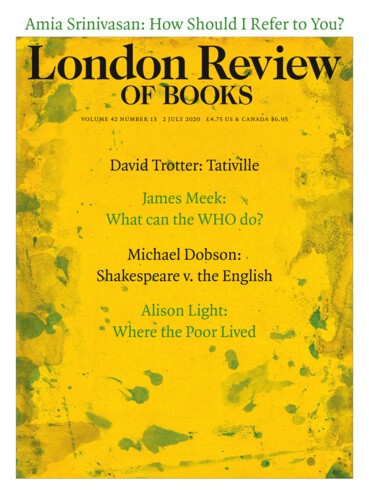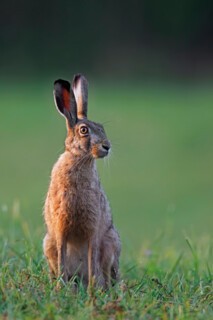Hares have always been thought magical. In their long-limbed quivering beauty, they were believed to be walking, breathing love potions. Philostratus warned his third-century readers that there were unscrupulous men out there who had found in the hare ‘a certain power to produce love and try to secure the objects of their affection by the compulsion of magic art’. Pliny suggested eating hares would increase your glamour: ‘The people think that if you eat a hare your body acquires sexual attractiveness for nine days, a vulgar superstition, which, however, must have some truth in it since the belief in it is so widespread.’ Martial writes to his Gellia, rather acidly: ‘Whenever you send me a hare, Gellia, you say to me, “You will be beautiful for seven days” … my love, if you mean what you say, you, Gellia, have never had a hare to eat.’ The hare was sacred to Aphrodite, goddess of love, and Eros can be found on droves of Greek vases, pursuing the hare in circles, or cradling one in his arms.
This sense of the hare as belonging to the arena of sex and desire stems in part from a belief in its astonishing fertility. Aristotle suggested in his Historia Animalium that the hare could get pregnant twice: they ‘breed and bear at all seasons, superfoetate (i.e. conceive again) during pregnancy’. Aristotle also suggested, it’s true, that eels spontaneously generate from the mud, but in fact he was right about hares: they can get pregnant while already pregnant. A male hare can fertilise a female during the later part of her pregnancy: the embryos will begin to develop while they wait in the oviduct until the delivery of the first pregnancy, and then, as soon as the uterus is freed up, move in. The time saved means they’re able to deliver around 30 per cent more offspring during a breeding season. It was long thought that hare parts could act as contraceptives. Aetius, writing in the imperial court in Constantinople, suggested that women ‘take seeds of henbane [a plant known more commonly as stinking nightshade], mix the milk of a she ass, a little myrtle and a berry of black ivy … to be worn after having been wrapped in the skin of a hare.’ (This was the same man who advised inserting children’s milk teeth inside a woman’s anus as an alternative form of contraception, advice I profoundly hope nobody took.)
Part of the hare’s magic was in the belief that it was hermaphrodite, a switcher-at-will. It was, Donatus writes: ‘modo mas, modo femina’ (sometimes male, sometimes female). Because of this, it became in antiquity a way to express homosexual love: in one of Terence’s comedies, Eunuchus, a bold young man, is told: ‘Quid ais, inquam, homo impudens? Lepus tute es, et pulpamentum quaeris.’ ‘What are you saying, impudent creature? You’re surely a hare and you seek flesh.’ A clay pot from 500 BC shows a man offering a live hare to a younger man. It was a thing to conjure love, both heterosexual and homosexual; a thing which, laid at your feet in its fine-featured loveliness, would either coax or magic away your doubts.
Some hares were also witches, or fairy-folk. Elizabeth Goudge’s astonishing children’s book of 1946, The Little White Horse, written just as the war ended, revels in sugar biscuits and exquisite beauties, and the hare is one the finest beauties of all. They are not, a boy explains, like rabbits: ‘A hare, now, that is a different thing altogether. A hare is not a pet but a person. Hares are clever and brave and loving, and they have fairy blood in them.’ One Celtic legend has the warrior-poet Oisín hunting a hare, which he injures in the leg. He follows it into thick brambles and, finding a door opening down into the ground, comes into a large hall, where a lovely woman sits, bleeding from a leg wound. The story is similar to the real-life trial for witchcraft in 1663 of an old woman called Julian Cox. A witness at the trial stated:
A huntsman swore that he went out with a pack of hounds to hunt a hare, and not far from Julian Cox’s house he at last started a hare. The dogs hunted her very close … till at last the huntsman perceiving the hare almost spent and making towards a great bush, he ran on the other side of the bush to take her up and preserve her from the dogs; but as soon as he laid hands on her it proved to be Julian Cox … He knowing her, was so affrighted that his hair on his head stood on end; and yet he spake to her and ask’d her what brought her there; but she was so far out of breath that she could not make him any answer … the huntsman and his dogs went home presently sadly affrighted.
So they were dangerous, as well as beautiful. A book on folklore from 1875 told that the hare moved in close association with calamity – it was recommended that, passing a hare, you should recite: ‘Hare before, Trouble behind: Change ye, Cross, and free me.’ A Middle English poem gives the hare’s 77 names, which you should list if you pass one to ward off ill luck (few are complimentary). Seamus Heaney’s translation has, among others:
The creep-along, the sitter-still,
the pintail, the ring-the-hill,
the sudden start, the shake-the-heart,
the belly-white, the lambs-in-flight.
The gobshite, the gum-sucker,
the scare-the-man, the faith-breaker,
the snuff-the-ground, the baldy skull,
(his chief name is scoundrel).
The hare’s actual name, lepus, came, the ancient Roman scholars said, from Latin levipes, ‘light foot’, and my God they deserve it. Brown hares can run at fifty miles an hour and jump ten feet: five times their own length in a single bound. To see a hare outrun a fox, zig-zagging to disrupt its momentum, is to know you are in the presence of the marvellous. Leverets are born with eyes open and fur on, ready to sprint: they live largely alone, do not make burrows, but rest in shallow indentations in the ground, never halting, always moving. ‘To kiss the hare’s foot’ is to be too late for dinner, according to Brewer’s Dictionary: ‘The hare has run away, and you are only in time to “kiss” the print of his foot.’ But they are not fast enough, of course, to outrun us. The number of hares in Britain has declined by 80 per cent in the last hundred years, in part because our relentless destruction of hedgerows killed their cover: between 1985 and 1997 alone, 184,000 km of the 640,000 km of hedgerows that ran through England and Wales were torn out and burned. And hares are the only game you can legally hunt all year round. We hunt them even in their mating season, when the females are boxing at would-be suitors in the fields, and shoot them in their thousands, as many as 300,000 a year. We might remind one another that we are slaughtering the Easter bunny. He was a hare long before he was a rabbit; the hare was sacred to Eostre, the Saxon goddess of spring – no rabidly cute bundle of fluff.
They have been thought holy, too. The ‘three hare’ motif appears in churches, temples and synagogues across the Far East and Europe, and throughout Britain: three hares running in a circle, their ears entwined. Hares have long been paired with the Virgin in her portraits (we have, perversely, considered them the epitome of both sex and virginity: it was for a while thought that they were so fertile they could reproduce without a mate). Their running bodies, set up on the roof bosses of churches, call up the Holy Trinity: one in three, three in one, prime mover in constant motion.
If beauty is enough to merit love – and we have historically reckoned that it is – then we should love the hare more than almost any other creature. The closer you get, the more beautiful they become: of the 32 species, some, such as the Burmese hare, are reddish-grey shading to silver; others, like the Tibetan Woolly, the colour of just-cut straw. The Indian Hare wears a patch of black at the back of its neck like a hair ribbon. The mountain hares in the north of Britain turn stark white in winter – real white, which only lasts a season, not the grubby white of most habitually white creatures. Their legs have the grandeur of Olympians, and their ears, black-tipped, lined in pink velvet and semi-translucent in the light, dwarf those of a rabbit. Seen in flight, their ears are banners streaming across a battleground. ‘The cat of the wood,’ Heaney calls them. ‘The stag of the cabbages.’ If there is magic in this world, some part of it lies with them. So if you are reading this, my love, I don’t need flowers, or jewels. Please, bring me a hare.
Send Letters To:
The Editor
London Review of Books,
28 Little Russell Street
London, WC1A 2HN
letters@lrb.co.uk
Please include name, address, and a telephone number.


